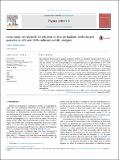Long-range two-particle correlations of strange hadrons with charged particles in pPb and PbPb collisions at LHC energies
Author(s)
Apyan, Aram; Barbieri, Richard Alexander; Busza, Wit; Cali, Ivan Amos; Di Matteo, Leonardo; Dutta, Valentina; Gomez-Ceballos, Guillelmo; Goncharov, Maxim; Gulhan, Doga Can; Klute, Markus; Lai, Yue Shi; Lee, Yen-Jie; Levin, Andrew Michael; Ma, Teng; Paus, Christoph M. E.; Ralph, Duncan Kelley; Stephans, George S. F.; Velicanu, Dragos Alexandru; Veverka, Jan; Wyslouch, Boleslaw; Yang, Mingming; Zanetti, Marco; Stoeckli, Fabian; Sumorok, Konstanty C; Wyslouch, Victoria; Bauer, Gerry P; Chan, M.; Luckey Jr, P David; Roland, Christof E; Roland, Gunther M; ... Show more Show less
DownloadKhachatryan-2015-Long-range two-parti.pdf (1.404Mb)
PUBLISHER_CC
Publisher with Creative Commons License
Creative Commons Attribution
Terms of use
Metadata
Show full item recordAbstract
Measurements of two-particle angular correlations between an identified strange hadron (K[0 over S] or [Λ over [bar over Λ]]) and a charged particle, emitted in pPb collisions, are presented over a wide range in pseudorapidity and full azimuth. The data, corresponding to an integrated luminosity of approximately 35 nb[superscript −1], were collected at a nucleon–nucleon center-of-mass energy (√s[subscript NN]) of 5.02 TeV with the CMS detector at the LHC. The results are compared to semi-peripheral PbPb collision data at √s[subscript NN] = 2.76 TeV, covering similar charged-particle multiplicities in the events. The observed azimuthal correlations at large relative pseudorapidity are used to extract the second-order (v[subscript 2]) and third-order (v[subscript 3]) anisotropy harmonics of K[0 over S] and [Λ over [bar over Λ]] particles. These quantities are studied as a function of the charged-particle multiplicity in the event and the transverse momentum of the particles. For high-multiplicity pPb events, a clear particle species dependence of v[subscript 2] and v[subscript 3] is observed. For p[subscript T]<2 GeV, the v[subscript 2] and v[subscript 3] values of K[0 over S] particles are larger than those of [Λ over [bar over Λ]] particles at the same p[subscript T]. This splitting effect between two particle species is found to be stronger in pPb than in PbPb collisions in the same multiplicity range. When divided by the number of constituent quarks and compared at the same transverse kinetic energy per quark, both v[subscript 2] and v[subscript 3] for K[0 over S] particles are observed to be consistent with those for [Λ over [bar over Λ]] particles at the 10% level in pPb collisions. This consistency extends over a wide range of particle transverse kinetic energy and event multiplicities.
Date issued
2015-01Department
Massachusetts Institute of Technology. Department of Physics; Massachusetts Institute of Technology. Laboratory for Nuclear Science; Massachusetts Institute of Technology. School of ScienceJournal
Physics Letters B
Publisher
Elsevier
Citation
“Long-Range Two-Particle Correlations of Strange Hadrons with Charged Particles in pPb and PbPb Collisions at LHC Energies.” Physics Letters B 742 (March 2015): 200–224.
Version: Final published version
ISSN
03702693